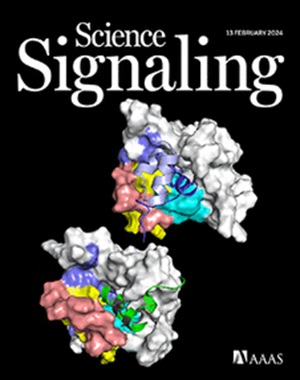促增殖信号中merlin-Rac拮抗的形态学调控
IF 6.6
1区 生物学
Q1 BIOCHEMISTRY & MOLECULAR BIOLOGY
引用次数: 0
摘要
板足是细胞外围薄的扇形突起,其延伸需要在小GTPase Rac1的控制下,分支肌动蛋白网络的组装。在黑色素瘤中,过度活跃的P29S Rac1突变体与针对BRAF和MAPK激酶的抑制剂的耐药性有关,并且与更具侵袭性的疾病有关,因为它隔离和失活异常大板足内的肿瘤抑制因子merlin(由NF2编码)。在这里,我们利用细胞形态学和信号动力学的定量活细胞成像研究了这些梅林失活的板足是如何维持的。我们发现,Rac1和merlin的活性在板叶基底的空间限制区域或微域内受到调控。merlin作为一种限制增殖的肿瘤抑制因子的作用需要它能够抑制板足延伸和局部抑制Rac1信号传导。相反,在板足中,梅林的局部失活释放了这些对形态和信号传导的限制,导致增殖增强。因此,Merlin和Rac1处于形态学和动态调节的双负反馈回路中,这是一种信号基序,可以放大和稳定板足延伸的适度刺激,使黑色素瘤能够在生长挑战下维持有丝分裂信号。这代表了细胞形态程序和生化信号之间的协作如何促进急性致癌性的一个例子。本文章由计算机程序翻译,如有差异,请以英文原文为准。
Morphological control of merlin-Rac antagonism in proliferation-promoting signaling
The extension of lamellipodia, which are thin, fanlike projections at the cell periphery, requires the assembly of branched actin networks under the control of the small GTPase Rac1. In melanoma, a hyperactive P29S Rac1 mutant is associated with resistance to inhibitors that target the kinases BRAF and MAPK and with more aggressive disease because it sequesters and inactivates the tumor suppressor merlin (encoded by NF2) inside abnormally large lamellipodia. Here, we investigated how these merlin-inactivating lamellipodia are maintained using quantitative, live cell imaging of cell morphology and signaling dynamics. We showed that Rac1 and merlin activity were regulated in spatially confined regions or microdomains within the lamellipodium. The role of merlin as a proliferation-limiting tumor suppressor required its ability to inhibit lamellipodial extension and to locally inhibit Rac1 signaling. Conversely, local inactivation of merlin in lamellipodia released these restraints on morphology and signaling, leading to enhanced proliferation. Merlin and Rac1 are thus in a morphologically and dynamically regulated double-negative feedback loop, a signaling motif that can amplify and stabilize modest stimuli of lamellipodia extensions that enable melanoma to sustain mitogenic signaling under growth challenge. This represents an example of how acute oncogenicity is promoted by collaborations between cell morphological programs and biochemical signaling.
求助全文
通过发布文献求助,成功后即可免费获取论文全文。
去求助
来源期刊

Science Signaling
BIOCHEMISTRY & MOLECULAR BIOLOGY-CELL BIOLOGY
CiteScore
9.50
自引率
0.00%
发文量
148
审稿时长
3-8 weeks
期刊介绍:
"Science Signaling" is a reputable, peer-reviewed journal dedicated to the exploration of cell communication mechanisms, offering a comprehensive view of the intricate processes that govern cellular regulation. This journal, published weekly online by the American Association for the Advancement of Science (AAAS), is a go-to resource for the latest research in cell signaling and its various facets.
The journal's scope encompasses a broad range of topics, including the study of signaling networks, synthetic biology, systems biology, and the application of these findings in drug discovery. It also delves into the computational and modeling aspects of regulatory pathways, providing insights into how cells communicate and respond to their environment.
In addition to publishing full-length articles that report on groundbreaking research, "Science Signaling" also features reviews that synthesize current knowledge in the field, focus articles that highlight specific areas of interest, and editor-written highlights that draw attention to particularly significant studies. This mix of content ensures that the journal serves as a valuable resource for both researchers and professionals looking to stay abreast of the latest advancements in cell communication science.
 求助内容:
求助内容: 应助结果提醒方式:
应助结果提醒方式:


